
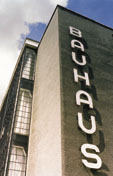

It was founded in 1919, and closed by the Nazis in 1933.
Walter Gropius (German-American, 1883-1969), Ludwig Mies van der Rohe (German-American, 1886-1969), Wassily Kandinsky (Russian-German, 1866-1944), Lyonel Feininger (American, 1871-1956), Paul Klee (Swiss-German, 1879-1940), Oskar Schlemmer (German, 1888-1943), László Moholy-Nagy (German, born Hungary, 1895-1946, active in the US), Josef Albers (German-American, 1899-1976), his wife Anni Fleischman Albers (German-American, 1899-1994), and other important artists were teachers there. Even though their styles were often quite varied, the artists of the Bauhaus had such a strong effect on art and art education that this school is often considered an art movement in itself.
Once the school was closed, many Bauhaus teachers emigrated to the U.S.A.
(pr. bou-house)
Examples of works by artists at the Bauhaus:

Wassily Kandinsky (Russian, 1866-1944), In the Gray, 1919, oil
on canvas, 129 x 176 cm,
Georges Pompidou Center, Paris.

Wassily Kandinsky, Kleine Welten, IV,
1922, color lithograph,
10 1/4 x 10 inches (26.6 x 25.5 cm), Cincinnati Art Museum, OH.

Wassily Kandinsky, Swinging, 1925, oil
on board, 70.5 x 50.2 cm, Tate Gallery, London. Kandinsky's book
Point and Line to Plane, published in 1926, explains the
meanings he ascribed to
the geometric imagery he
put into such paintings as Swinging.

Wassily Kandinsky, Lightly Touching (Leicht Berührt), 1931, oil on canvas, 27 5/8 x 19 1/4 inches (69.9 x 48.8 cm), Museum of Modern Art, NY.
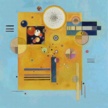
Wassily Kandinsky, Soft Pressure, 1931, oil on plywood, 39 1/4 x 39 inches (99.5 x 99 cm), Museum of Modern Art, NY.

Lyonel Feininger (American, worked in Germany,
1871-1956), publisher and printer: Staatliches Bauhaus, Weimar, Kathedrale (Cathedral), 1919, woodcut, composition: 12 x 7 1/2 inches (30.5 x 19.0 cm); sheet 16 x 12 inches (41.0 x 30.5 cm), edition: unknown.

Lyonel Feininger, Hopfgarten, 1920, oil on canvas, 32 1/4 x 25 inches, Minneapolis Institute of Arts.
Paul Klee (Swiss, born Germany, 1879-1940), Birds Making Scientific Experiments in Sex, pen and black ink, signed and dated 1915 and numbered 28 on the mount, 7 6/16 x 4 5/8 inches (18.8 x 11.9 cm), Michael C. Carlos Museum. Also see drawing and Swiss art.

Paul Klee, They're Biting, 1920, drawing and oil
on paper, 31.1 x 23.5 cm, Tate
Gallery, London.

Paul Klee, Temple Gardens, 1920, gouache and traces of ink
on paper, 7 1/4 x 10 1/4 inches
(18.4 x 26.7 cm), Metropolitan Museum of Art, NY.

Paul Klee, Comedy, 1921, watercolor and oil
on paper, 30.5 x 45.4 cm, Tate
Gallery, London.

Paul Klee, Pflanzenwachstum (Growth), 1921, oil on cardboard,
54 x 40 cm, Georges Pompidou Center, Paris.

Paul Klee, Dying Plants (Sterbende Pflanzen), 1922, watercolor on paper, 17 7/8 x 12 inches (45.5 x 30.5 cm), Museum of Modern Art, NY.

Paul Klee, A Young Lady's Adventure, 1922, watercolor on paper,
43.8 x 32.1 cm, Tate Gallery, London.
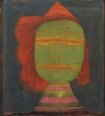
Paul Klee, Actor's Mask (Schauspielermaske), 1924, oil on canvas, mounted on board, 14 1/2 x 13 3/8 inches (36.7 x 33.8 cm), Museum of Modern Art, NY.

Paul Klee, Around the Fish (Um den Fisch), 1926, oil on canvas, 18 3/8 x 25 1/8 inches (46.7 x 63.8 cm), Museum of Modern Art, NY.
Paul Klee, Historical Place, 1927, watercolor and ink on paper on card on board, 35.5 x 48.7 cm, Tate Gallery, London.

Paul Klee, Pastoral (Pastorale), 1927, tempera on canvas, mounted on wood, 27 1/4 x 20 5/8 inches (69.3 x 52.4 cm), Museum of Modern Art, NY.

Paul Klee, Portrait of an Acrobat (Artistenbildnis), 1927, oil and collage on cardboard over wood with painted plaster border, 24 7/8 x 15 3/4 inches (63.2 x 40 cm), Museum of Modern Art, NY.

Paul Klee, Cat and Bird (Katze und Vogel), 1928, oil and ink on gessoed canvas, mounted on wood, 15 x 21 inches (38.1 x 53.2 cm), Museum of Modern Art, NY.

Paul Klee, Howling Dog, 1928, oil
on canvas, 17 1/2 x 22
3/8 inches, Minneapolis Institute of Arts.

Paul Klee, Fire at Evening (Feuer Abends), 1929, oil on cardboard, 13 3/8 x 13 1/4 inches (33.8 x 33.4 cm), Museum of Modern Art, NY.

Paul Klee, Pfeil im Garten (Arrow in the Garden),
1929, oil and tempera
on canvas, 70 x 50.2 cm,
Georges Pompidou Center, Paris.
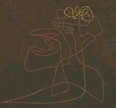
Paul Klee, The Mocker Mocked (Oder der verspottete Spötter), 1930, oil on canvas, 17 x 20 5/8 inches (43.2 x 52.4 cm), Museum of Modern Art, NY.

Paul Klee, Rhythmisches (In Rhythm), 1930, oil
on woven jute, 69.6 x 50.5 cm, Georges Pompidou Center, Paris.
See rhythm.

Paul Klee, Castle Garden (Schlossgarten), 1931, oil on canvas, 26 1/2 x 21 5/8 inches (67.2 x 54.9 cm), Museum of Modern Art, NY.

Paul Klee, Mask of Fear (Maske Furcht), 1932, oil on burlap, 39 1/2 x 22 1/2 inches (100.4 x 57.1 cm), Museum of Modern Art, NY.

Josef Hartwig (German, 1880-1955), manufactured by Bauhaus, Weimar, Chess Set, 1924, pear wood, natural and stained black, smallest: 7/8 x 7/8 x 7/8 inches (2.2 x 2.2 x 2.2 cm), largest: 1 7/8 x 1 1/8 x 1 1/8 inches (4.8 x 2.9 x 2.9 cm), Museum of Modern Art, NY. See chess and wood.
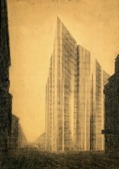
Ludwig Mies van der Rohe (German, 1886-1969), Friedrichstrasse Skyscraper, Berlin-Mitte, Germany, a project in 1921, this is a perspective drawing from the north, charcoal and pencil on tracing paper mounted on board, 68 1/4 x 48 inches (173.4 x 121.9 cm), Museum of Modern Art, NY. This design for a twenty-story tower was based on the then-untried curtain wall idea: that a supporting steel skeleton would be able to free the exterior walls from their load-bearing function, allowing a building to have a surface that is more translucent than solid. Mies van der Rohe was the last director of the Bauhaus design school in Dessau, from 1930 until its closing in 1932.

Ludwig Mies van der Rohe, designer, "MR" Armchair, 1927, chrome-plated steel and painted
caning, 31 1/2 x 22 x
37 inches (80 x 55.9 x 94 cm), Metropolitan Museum of Art, NY.
This was developed from a 1924 design for a cantilevered
chair by Mart Stam. It was introduced by Mies van der Rohe at
the 1927 Stuttgart exhibition and has remained in production
ever since.
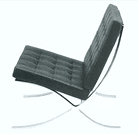
Ludwig Mies van der Rohe, Barcelona Chair,
1929, chrome-plated
steel and black
leather, manufactured by Knoll International.
See furniture.

Johannes Itten (Swiss, 1888-1967), Space Composition, I (Raum Komposition I), 1944, oil on canvas, 25 5/8 x 19 3/4 inches (65.1 x 50.1 cm), Museum of Modern Art, NY. See color and Swiss art.

Johannes Itten (Swiss, 1888-1967), Space Composition, II (Raum Komposition II), 1944, oil on canvas, 25 5/8 x 19 5/8 inches (65.1 x 49.7 cm), Museum of Modern Art, NY.

Oskar Schlemmer (German, 1888-1943), Head, 1928, oil and graphite on canvas, 15 7/8 x 11 3/4 inches (40.4 x 29.8 cm), Museum of Modern Art, NY.

Oskar Schlemmer, Bauhaus Stairway, 1932, oil on canvas, 63 7/8 x 45 inches (162.3 x 114.3 cm), Museum of Modern Art, NY.

Willi Baumeister (German, 1889-1955), Mauerbild mit Kreis (Mural with Circle),
1923, oil on canvas,
with cardboard painted
in oil mounted on canvas,
121 x 72 x 3.3 cm, Georges Pompidou Center, Paris.

![]()

Marianne Brandt (German, 1893-1983), manufactured by Bauhaus Metal Workshop, Germany, Ashtray, 1924, brass and nickel-plated metal, height 2 3/4 (7 cm), diameter 3 1/8 inches (7.9 cm), Museum of Modern Art, NY.

László Moholy-Nagy (American, born Hungary, 1895-1946; in Germany 1921-34; U.S.A. 1937-46), Yellow Circle, 1921, oil on canvas, 53 1/8 x 45 inches (135 x 114.3 cm), Museum of Modern Art, NY.
See German art and Hungarian art.

László Moholy-Nagy, K VII, 1922, oil
on canvas, 115.3 x 135.9
cm, Tate Gallery, London. See geometric.

László Moholy-Nagy, Telephone Picture EM 2 (Telephonbild), 1922, porcelain enamel on steel, 18 3/4 x 11 7/8 inches (47.5 x 30.1 cm), Museum of Modern Art, NY.

László Moholy-Nagy, Untitled (Positive), c.
1922-1924, gelatin silver print from photogram
negative, 23.7 x 17.8
cm (9 5/16 x 7 inches), National Gallery of Art, Washington D.C.

László Moholy-Nagy, Q 1 Suprematistic, 1923, oil on canvas, 37 1/2 x 37 1/2 inches (95.2 x 95.2 cm), Museum of Modern Art, NY.
László Moholy-Nagy, Composition A.XX, 1924, oil
on canvas, 135.5 x 115
cm, Georges Pompidou Center, Paris.

László Moholy-Nagy, Space Modulator L3, 1936, oil on perforated zinc and composition board, with glass-headed pins, 17 1/4 x 19 1/8 inches (43.8 x 48.6 cm), Museum of Modern Art, NY.
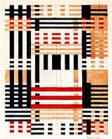
Anni Albers (born Analise Fleischman, married Josef Albers) (German, 1899-1994), Design for Wall Hanging, 1926, gouache and pencil on paper, 14 x 11 1/2 inches (35.6 x 29.2 cm), Museum of Modern Art, NY. See textile.

Herbert Bayer (American, born Germany, 1900-1985), Bauhaus Dessau, 1926, letterpress, 8 1/2 x 5 7/8 inches (21.6 x 14.9 cm), Printer: Bauhausdruck, Museum of Modern Art, NY. See graphic design.
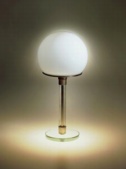
Wilhelm Wagenfeld (German, 1900-1990) and Carl J. Jucker (German), manufactured by Bauhaus Metal Workshop, Germany, Table Lamp, 1923-24, glass and chrome-plated metal, height 18 (45.7 cm), diameter of globe 8 inches (20.3 cm), diameter at base 5 1/2 inches (14 cm), Museum of Modern Art, NY.
Lux Feininger (American, born Germany, 1910-),
Clemens Röseler, c. 1928, gelatin
silver print, 11.3 x 8.9 cm (4 7/16 x 3 1/2 inches), Metropolitan
Museum of Art, NY.
Also see Arts and Crafts Movement, abstraction, applied arts, Art Deco, Blaue Vier, Der Blaue Reiter, Die Brücke, German art, and new media.
https://inform.quest/_art
Copyright © 1996-![]()